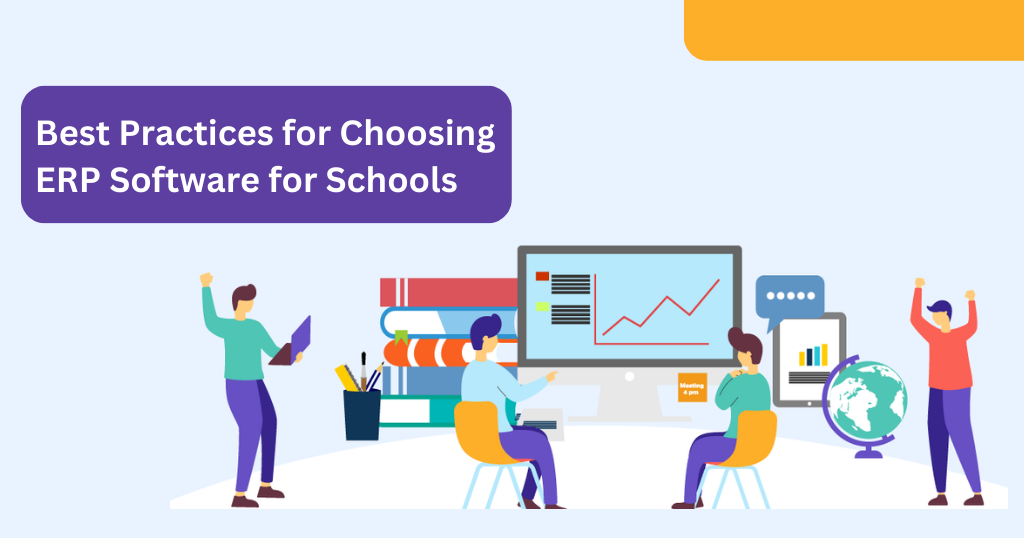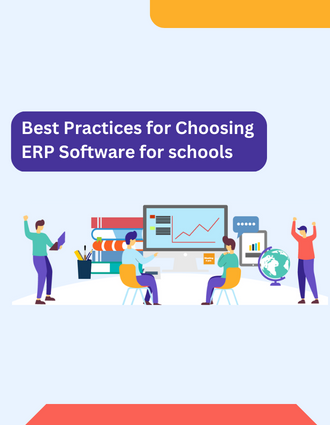Practices for Choosing an ERP Software for Schools
In the fast-paced world of education, efficiency, and organization are vital in ensuring smooth operations and effective management. That’s where ERP software for schools comes to the rescue! With its comprehensive features and user-friendly interfaces, ERP is revolutionizing the way educational institutions manage their administrative tasks.
In this article, we will explore the best practices for choosing a school ERP software solution that perfectly aligns with your institution’s needs. So, let’s embark on this journey of streamlining education management.
Factors To Consider for Choosing the Best ERP Software for Schools

Choosing school management software is an important decision that can have a huge impact on your institution’s efficiency and effectiveness. With so many options available in the market, it’s essential that you consider these points before making a choice.
By carefully considering these factors, you can make an informed decision and select a school management software that seamlessly aligns with your institution’s requirements, streamlines administrative processes, and enhances overall productivity.
1. Assess Your Requirements
First, you need to assess the difficulties you usually face while managing administrative tasks such as admissions, attendance, fee management, or grading systems before checking the wide range of school management software available.
It’s important to assess the specific needs of your institution. This evaluation will help you identify the essential features and functionalities you require in an educational ERP software solution. By doing so, you can make a smart and informed decision that meets your institution’s unique requirements.
2. Opt for Cloud-Based Solutions
In this era of digital transformation, cloud-based online school management software has become the go-to choice for educational institutions. The flexibility and accessibility offered by cloud-based software solutions allow you to access the software anytime, anywhere, with just an internet connection.
It eliminates the need for complex installations and offers seamless updates, ensuring that you always have the latest features and enhancements at your fingertips.
3. Offline and Online Mode of School Applications
In a time when internet connectivity can sometimes be unreliable, having the choice to use school applications in both offline and online modes is really helpful. It means that users can access and use the software even in areas where the internet is limited or unstable.
Offline functionality allows important tasks to be carried out without any disturbance, and the data can be synchronized later when a stable internet connection is available. This feature adds convenience and ensures that operations can continue smoothly in different situations without any interruptions.
4. User-Friendly Interface
One of the essential factors to consider when choosing a school management system is its user interface. A friendly and intuitive interface makes it easier for staff, teachers, and administrators to navigate and utilize the software effectively.
Look for a solution that offers a clean and organized layout with easy-to-use menus and features. A user-friendly interface reduces the learning curve, enhances productivity, and ensures a positive experience for everyone involved.
5. Flexibility
Schools have their own special ways of doing things, and these can change as time goes on. The software used in schools should be able to adjust to these changes and be customized to fit the school’s needs. This flexibility means that the software can easily work together with other systems already in place, follow personalized ways of doing things, and be improved in the future.
6. Integration Capabilities
Efficient data management is crucial for an effective school management system. Look for an ERP software solution that seamlessly integrates with other systems or platforms you currently use, such as student information systems (SIS), learning management systems (LMS), or communication tools. Integration capabilities allow for data synchronization and real-time updates, eliminating the need for duplicate data entry and streamlining information flow across different systems.
7. Data Security
When picking a school ERP software, it’s super important to make sure that student data is kept safe and secure. You want to choose a software provider who takes data protection seriously and follows the rules about privacy.
Look for things like strong protection for data with special coding, controls that limit who can access what, making backups of data regularly, and strong ways to check that users are who they say they are. If the software is trustworthy, it will make everyone involved feel confident that students’ private information is always protected.
8. Customization and Scalability
Each educational institution is unique, and so are their requirements. A good ERP software solution should offer customization options to adapt to your specific workflows and processes. Look for a solution that allows you to tailor the software to match your institution’s branding, terminology, and particular needs.
Additionally, consider the scalability of the software. As your institution grows, the software should be able to accommodate an increasing number of users, data, and functionalities without compromising performance.
9. Reliable Support and Training
When you introduce a new online school management software, it might take some time for your staff and administrators to get used to it. That’s why it’s important to choose a software provider who offers helpful training and support.
They should give you resources like user guides, videos that show you how to use the software or ways to reach out for help when you need it. Having good support and training will help your team use the software effectively and deal with any problems that might come up.
10. Scalability for Sustenance
When schools get bigger and have more students and staff, their needs change too. That’s why it’s important to pick a school ERP software that can grow with them. The software should be able to handle more students, staff, and data without slowing down or having problems. This scalability helps the software stay efficient and useful as the school gets bigger, making sure it can keep working well for a long time.
Wrapping Up
Choosing the right ERP software for schools is a significant decision that can transform the way your educational institution manages its administrative tasks. By following these best practices, you can make an informed choice that aligns with your specific needs and goals.
From assessing your requirements to opting for cloud-based solutions, prioritizing user-friendliness, integration capabilities, customization, and scalability, and ensuring reliable support and training, you are setting the stage for streamlined education management with ease.
With Proctur’s advanced ERP system, digital transformation and automation have become simple tasks for institutions.



